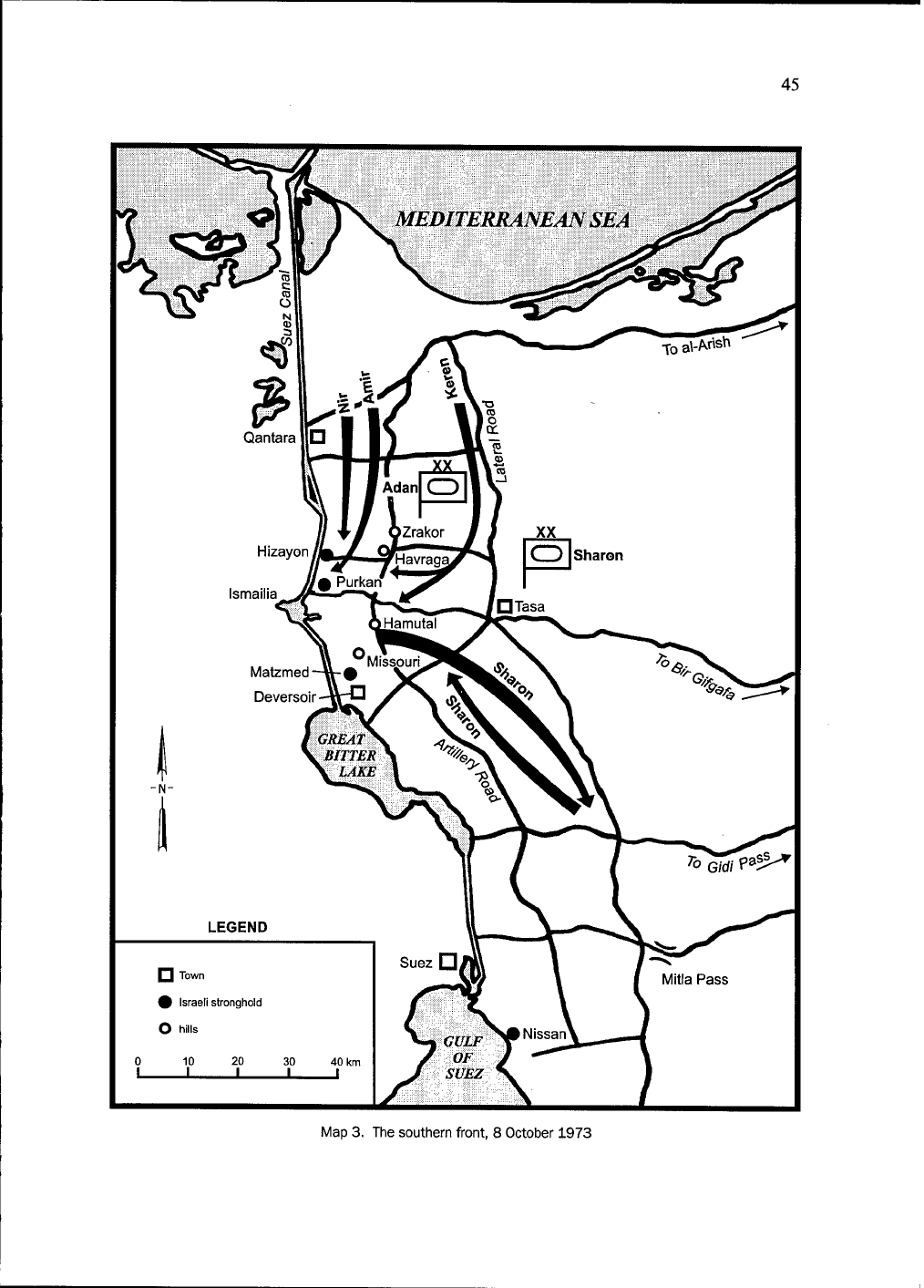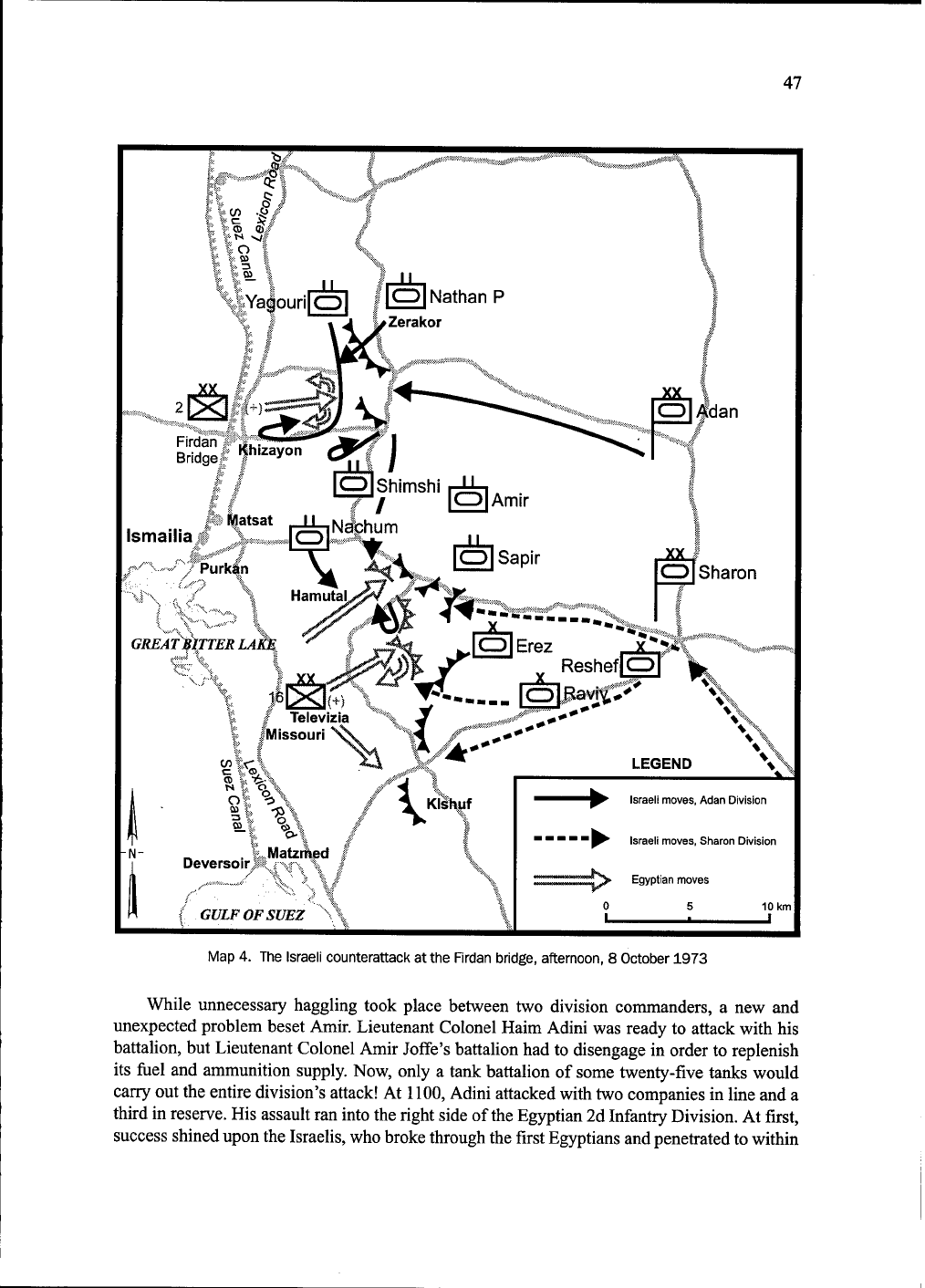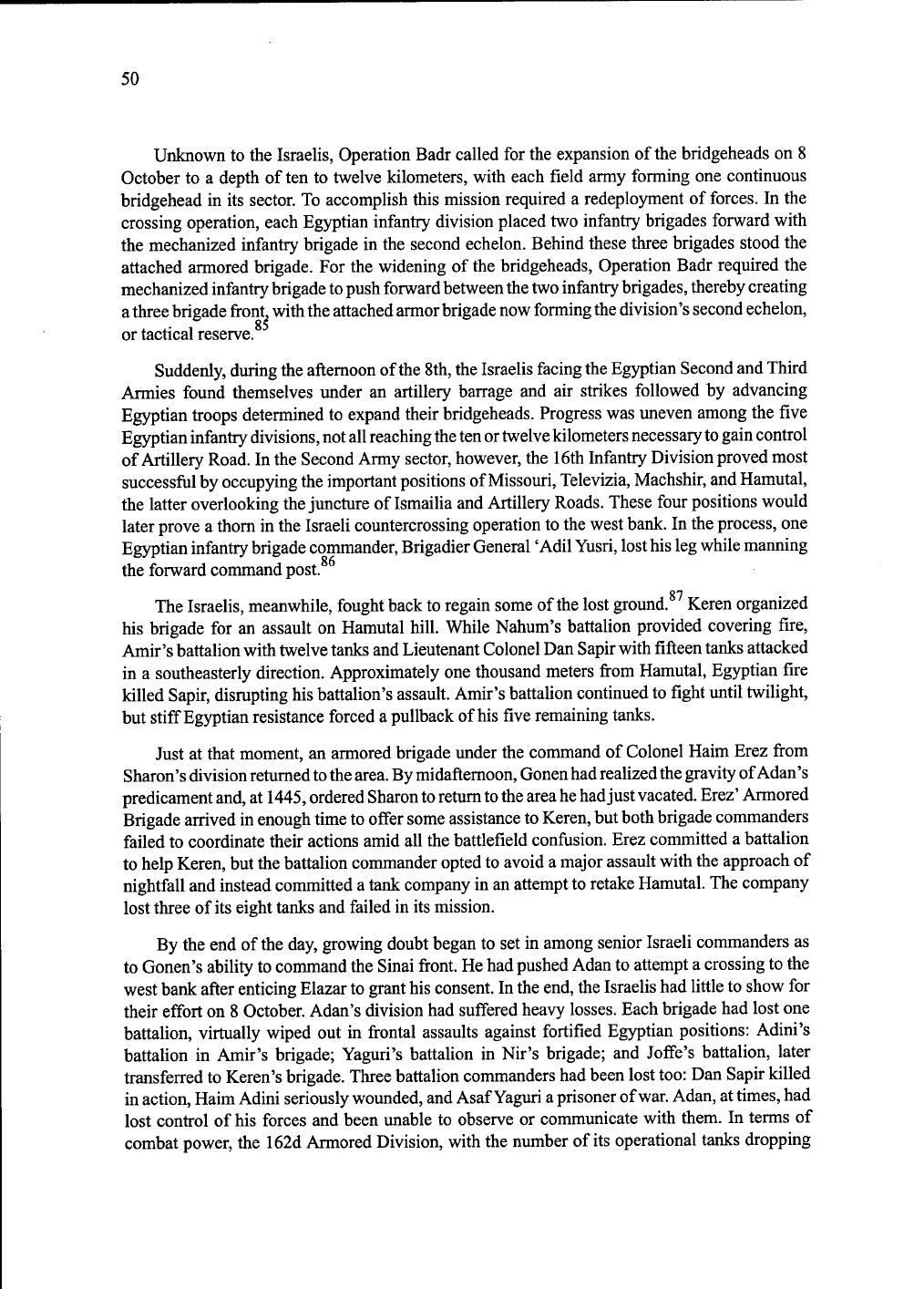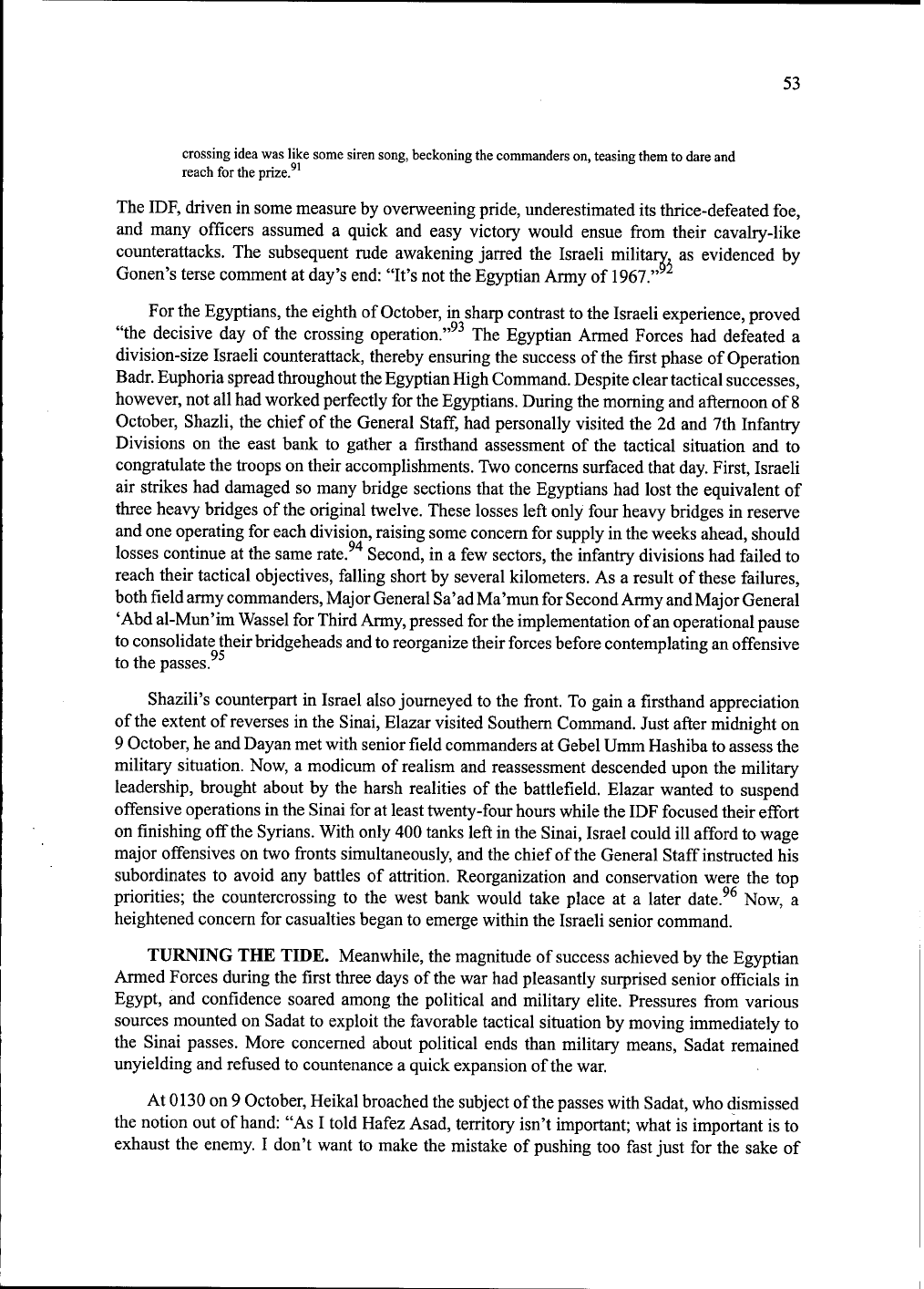Gawrych George W. The 1973 Arab-Israeli War: The Albatross of Decisive Victory (Leavenworth Papers No.21)
Подождите немного. Документ загружается.


45
Map
3.
The
southern
front,
8
October
1973

46
would
conduct
offensive
operations
against
the
16th
Infantry
Division's
bridgehead
toward
79
Matzmed.
The
move
south
quickly
ran
amiss.
Instead
of
moving
three
kilometers
from
the
canal
just
east
of
Lexicon,
Amir
advanced
along
Artillery
Road,
completely
missing
the
Egyptian
bridge-
heads.
For
his
part,
Keren
moved
through
Sharon's
sector
to
get
into
position.
As
a
result
of
his
error
in
navigation,
Amir
would
eventually
have
to
attack
east
to
west
instead
of
north
to
south.
The
frontal,
instead
of
flank,
assaults
would
play
directly
into
the
strong
Egyptian
defenses
and
cause
heavy
Israeli
casualties,
aiding
Sadat's
war
strategy
of
bleeding
the
IDF.
Around
0900,
advance
elements
of
Amir's
brigade
reached
the
plain
between
Artillery
Road
and
the
Firdan
bridge
without
encountering
any
significant
Egyptian
opposition.
(See
map
4.)
Awaiting
Amir,
however,
was
the
Egyptian
2d
Infantry
Division
reinforced
with
the
24th
Armored
Brigade
from
the
23
d
Mechanized
Infantry
Division.
Two
Egyptian
infantry
brigades
formed
the
first
echelon,
with
a
mechanized
infantry
brigade
constituting
the
second
echelon.
The
24th
Armored
Brigade
formed
the
divisional
reserve,
but
Brigadier
General
Hasan
Abu
Sa'ada
could
commit
the
tank
brigade
only
in
the
event
of
an
Israeli
penetration
into
the
divisional
bridgehead.
In
the
face
of
a
reinforced
Egyptian
infantry
division,
Amir's
two-battalion
force
lacked
light
reconnaissance
units,
81
-mm
self-propelled
mortars,
and
armored
infantry.
Without
air
cover
and
artillery,
Amir
had
to
rely
on
tanks
alone
to
attack
defended
positions.
A
malfunction
in
his
direct
communications
with
Adan
further
complicated
matters.
Despite
all
of
these
problems,
Gonen
was
confident
of
certain
victory.
After
all,
Adan's
division
had
managed
to
advance
virtually
unimpeded
from
north
to
south.
Consequently,
Gonen
wanted
Adan
to
link
up
with
the
strong-
point
at
Hizayon
for
the
purpose
of
crossing
to
the
west
bank
and
telephoned
to
Tel
Aviv
for
permission
to
do
so.
At
1005,
Southern
Command
even
reported
the
imminent
collapse
of
the
Egyptian
Army.
At
0955,
choosing
to
ignore
or
downplay
negative
reports
reaching
him,
Gonen
reported
only
positive
developments
on
the
battlefield
to
General
Headquarters
and
requested
permission
to
cross
to
the
west
bank.
His
request
found
Elazar
attending
an
important
meeting
of
Meir's
war
cabinet.
Rather
than
excuse
himself
from
the
session,
the
chief
of
the
General
Staff
preferred
to
deal
with
Gonen
through
his
assistant
at
the
Pit.
As
a
result
of
this
peculiar
arrangement,
some
miscommunication
occurred
during
the
transmissions
between
Gonen,
the
Pit,
and
Elazar.
With
each
interruption
at
Meir's
cabinet
meeting—there
were
at
least
five
over
the
span
of
an
hour—Elazar
found
himself
gradually
accepting
the
optimistic
reports
from
Southern
Command
and
approving
a
countercrossing
and
release
of
Sharon
to
head
south—all
without
ever
having
talked
directly
with
Gonen!
8
1
After
the
war,
many
would
criticize
Elazar
for
operating
in
such
an
unorthodox
manner.
At
1040,
Southern
Command
ordered
Adan
to
cross
to
the
west
bank
and
gave
Sharon
the
green
light
to
head
south
toward
Suez
City.
Short
of
forces,
both
Adan
and
Amir
appealed
to
Gonen,
asking
for
Sharon
to
detach
an
armored
battalion
to
protect
the
162d
Armored
Division's
southern
flank.
Gonen
consented
to
the
request,
but
Sharon
refused
to
comply—a
refusal
that
would
later
result
in
the
loss
of
several
critical
positions
to
the
Egyptians.

47
4t
o
|Ya|ouri|CD
[CDj
Nathan
P
►
Zerakor
CDlidan
i
cmai
i
ia
Matsat
ÄlNihum
Ismailia
ICDI»«*^
11
X^
OSapir
Purkin
Hamutal
GREATlEflTTER
LAXM,
Televizia
Missouri
CD
I
Sharon
i#/
x
Reshef
l
|(V\
y-
[
gl߻flg>
\
Klsh^if
@\
%
LEGEND
N-
_
.
kMatzmed
i
Deversoir
GULF
OF
SUEZ
\
%
_
A.
►
Israeli
moves,
Adan
Division
Israeli
moves,
Sharon
Division
™
J>
Egyptian
moves
0
5
10
km
—I
Map
4.
The
Israeli
counterattack
at
the
Firdan
bridge,
afternoon,
8
October
1973
While
unnecessary
haggling
took
place
between
two
division
commanders,
a
new
and
unexpected
problem
beset
Amir.
Lieutenant
Colonel
Haim
Adini
was
ready
to
attack
with
his
battalion,
but
Lieutenant
Colonel
Amir
Joffe
's
battalion
had
to
disengage
in
order
to
replenish
its
fuel
and
ammunition
supply.
Now,
only
a
tank
battalion
of
some
twenty-five
tanks
would
carry
out
the
entire
division's
attack!
At
1100,
Adini
attacked
with
two
companies
in
line
and
a
third
in
reserve.
His
assault
ran
into
the
right
side
of
the
Egyptian
2d
Infantry
Division.
At
first,
success
shined
upon
the
Israelis,
who
broke
through
the
first
Egyptians
and
penetrated
to
within

48
Israeli
M-48
tank
racing
to
counterattack
Egyptian
armor
concentrations
near
the
canal
800
meters
of
the
canal.
But
then,
a
torrential
downpour
of
antitank,
tank,
and
artillery
fire
descended
upon
Adini's
meager
force,
destroying
eighteen
of
his
twenty-five
tanks
within
minutes
and
wounding
Adini
along
with
two
company
and
two
platoon
commanders.
The
battalion
suffered
twenty
killed,
including
two
platoon
commanders.
Making
the
situation
worse,
Adan
lost
communications
with
Gabi
Amir
and
was
therefore
initially
unaware
of
the
fate
of
the
attack.
83
Despite
this
first
setback,
the
Israelis
had
the
opportunity
to
regroup
to
conduct
a
coordinated
three-brigade
assault
toward
Firdan
bridge,
but
this
attack
proved
no
more
successful
than
the
previous
one.
84
Nir
had
disengaged
at
Qantara
and,
having
left
one
battalion
behind,
arrived
at
1230
in
the
area
of
the
Firdan
bridge
with
two
tank
battalions.
Nir
and
Amir
held
a
brief
conference
to
discuss
plans
for
attacking
toward
the
bridge.
Meanwhile,
Keren
moved
into
the
area
as
well,
and
Adan
ordered
him
to
support
Amir
and
Nir
by
attacking
in
the
direction
of
Purkan.
Once
again,
the
situation
began
unraveling
for
the
Israelis.
Gonen,
confident
of
an
Egyptian
collapse,
had
already
ordered
Sharon
to
vacate
the
area
around
Tasa
for
a
move
to
Suez
City.
In
its
tracks,
the
143d
Armored
Division
left
only
a
reconnaissance
company
to
hold
the
critical
ridges
of
Hamadia
and
Kishuf,
but
not
the
hills
north
of
them,
such
as
Hamutal.
Sharon's
departure
suddenly
exposed
Adan's
southern
flank
at
a
time
when
the
battle
with
the
Egyptians

49
was
going
badly.
Keren's
Armored
Brigade,
by
default,
gained
responsibility
for
Adan's
left
side.
After
the
war,
Adan
and
Sharon
exchanged
several
verbal
salvos
over
this
turn
of
events.
Meanwhile,
the
anticipated
attack
by
Nir
and
Amir
faced
enormous
difficulties.
Nir
pos-
sessed
some
fifty
tanks
in
two
battalions,
one
under
Lieutenant
Colonel
Asaf
Yaguri
and
the
other
under
Lieutenant
Colonel
Natan.
Gabi
Amir,
for
his
part,
was
in
dire
need
of
additional
forces
to
assault
entrenched
positions.
He
had
virtually
lost
Adini's
entire
battalion
and
had
released
Natan
to
replenish
this
battalion.
Suddenly
and
fortuitously,
Lieutenant
Colonel
Eliashiv
Shemshi
appeared
with
his
armored
(reserve)
battalion
with
twenty-five
tanks,
two
half-tracks,
and
two
jeeps.
Shemshi
had
just
arrived
on
the
battlefront
in
an
attempt
to
join
up
with
Keren's
Armored
Brigade.
Desperate
for
more
armor,
Amir
quickly
received
Adan's
permission
to
commandeer
Shemshi's
battalion
to
use
in
coordination
with
an
assault
on
Firdan
bridge.
Amir
then
ordered
Shemshi
to
provide
covering
fire
for
Nir's
assault
on
Firdan
bridge.
Such
"theft"
of
units
and
equipment
happened
frequently
during
the
war,
as
field
command-
ers
responded
to
immediate
threats
and
urgent
orders
in
the
midst
of
the
fog
and
friction
of
war.
The
confusion
often
left
tactical
commanders
without
a
clear
picture
of
the
battlefield
and
their
particular
part
in
it,
and
the
myriad
kinks
in
execution
accentuated
each
commander's
immediate
concerns
and
threats.
The
fact
that
the
initiative
lay
squarely
in
Egyptian
hands
compounded
the
confusion
and
uncertainty
and
forced
Israeli
commanders
to
be
more
reactive
than
proactive.
As
a
result,
Israeli
battalion,
brigade,
and
division
commanders
experienced
difficulty
in
coordinat-
ing
their
units
to
counterattack
toward
what
were
not
always
clearly
defined
and
attainable
objectives.
Though
affected
by
the
stress
and
chaos
of
the
battlefield,
the
Israelis,
nonetheless,
pressed
a
second
attack
toward
Firdan
bridge
at
1330.
As
the
first
attempt
ofthat
morning,
this
combined
attack
again
lacked
proper
coordination
in
the
face
of
overwhelming
enemy
forces.
Natan
and
Yaguri
began
to
move
their
battalions
at
the
same
time,
the
former
on
the
right,
the
latter
on
the
left.
Suddenly,
heavy
Egyptian
fire
stopped
Natan
's
tank
battalion,
leaving
only
Yaguri
to
proceed
with
twenty-five
tanks.
Shemshi,
who
had
no
idea
of
Yaguri's
identity,
assumed
that
the
battalion
belonged
to
Amir
when
in
fact
it
formed
part
of
Nir's
brigade.
The
assault
thus
involved
two
battalions,
from
two
different
brigades,
which
had
no
direct
communication
between
their
two
tactical
headquarters.
Yaguri
charged
in
line,
cavalry
style,
leaving
Shemshi
to
watch
helplessly
as
fellow
Israeli
tankers
charged
into
the
jaws
of
disaster.
The
second
assault
on
Firdan
failed
miserably.
Warned
in
advance
by
intelligence,
Brigadier
General
Abu
Sa'ada,
the
commander
of
the
Egyptian
2d
Infantry
Division,
had
prepared
his
forces
for
the
expected
attack.
Yaguri
now
stumbled
into
a
killing
zone
{ard
qatl)
between
the
two
forward
brigades
and
straight
into
the
Egyptian
mechanized
infantry
brigade.
Within
minutes,
an
avalanche
of
Egyptian
fire
destroyed
eighteen
tanks
and
killed
thirty-two
Israelis.
Yaguri
and
three
other
soldiers
were
captured.
By
the
end
of
the
day,
Nir
reported
fifty-four
men
missing
in
action.
Among
the
Egyptians
killed
were
Colonel
Fatin
Diyab
and
Lieutenant
Colonel
Ibrahim
Zeydan,
the
latter
a
battalion
commander.
That
evening,
the
Egyptian
military
displayed
its
prize
captive,
Lieutenant
Colonel
Asaf
Yaguri,
on
national
television
to
bolster
public
morale.
(A
military
spokesman
in
Cairo
wrongly
identified
Yaguri
as
a
brigade
commander.)
The
next
day,
Egyptian
newspapers
carried
exclusive
stories
and
pictures
of
Israeli
prisoners
of
war.

50
Unknown
to
the
Israelis,
Operation
Badr
called
for
the
expansion
of
the
bridgeheads
on
8
October
to
a
depth
of
ten
to
twelve
kilometers,
with
each
field
army
forming
one
continuous
bridgehead
in
its
sector.
To
accomplish
this
mission
required
a
redeployment
of
forces.
In
the
crossing
operation,
each
Egyptian
infantry
division
placed
two
infantry
brigades
forward
with
the
mechanized
infantry
brigade
in
the
second
echelon.
Behind
these
three
brigades
stood
the
attached
armored
brigade.
For
the
widening
of
the
bridgeheads,
Operation
Badr
required
the
mechanized
infantry
brigade
to
push
forward
between
the
two
infantry
brigades,
thereby
creating
a
three
brigade
front,
with
the
attached
armor
brigade
now
forming
the
division's
second
echelon,
or
tactical
reserve.
Suddenly,
during
the
afternoon
of
the
8th,
the
Israelis
facing
the
Egyptian
Second
and
Third
Armies
found
themselves
under
an
artillery
barrage
and
air
strikes
followed
by
advancing
Egyptian
troops
determined
to
expand
their
bridgeheads.
Progress
was
uneven
among
the
five
Egyptian
infantry
divisions,
not
all
reaching
the
ten
or
twelve
kilometers
necessary
to
gain
control
of
Artillery
Road.
In
the
Second
Army
sector,
however,
the
16th
Infantry
Division
proved
most
successful
by
occupying
the
important
positions
of
Missouri,
Televizia,
Machshir,
and
Hamutal,
the
latter
overlooking
the
juncture
of
Istnailia
and
Artillery
Roads.
These
four
positions
would
later
prove
a
thorn
in
the
Israeli
countercrossing
operation
to
the
west
bank.
In
the
process,
one
Egyptian
infantry
brigade
commander,
Brigadier
General'
Adil
Yusri,
lost
his
leg
while
manning
the
forward
command
post.
QH
The
Israelis,
meanwhile,
fought
back
to
regain
some
of
the
lost
ground.
Keren
organized
his
brigade
for
an
assault
on
Hamutal
hill.
While
Nahum's
battalion
provided
covering
fire,
Amir's
battalion
with
twelve
tanks
and
Lieutenant
Colonel
Dan
Sapir
with
fifteen
tanks
attacked
in
a
southeasterly
direction.
Approximately
one
thousand
meters
from
Hamutal,
Egyptian
fire
killed
Sapir,
disrupting
his
battalion's
assault.
Amir's
battalion
continued
to
fight
until
twilight,
but
stiff
Egyptian
resistance
forced
a
pullback
of
his
five
remaining
tanks.
Just
at
that
moment,
an
armored
brigade
under
the
command
of
Colonel
Haim
Erez
from
Sharon's
division
returned
to
the
area.
By
midafternoon,
Gonen
had
realized
the
gravity
of
Adan's
predicament
and,
at
1445,
ordered
Sharon
to
return
to
the
area
he
had
just
vacated.
Erez'
Armored
Brigade
arrived
in
enough
time
to
offer
some
assistance
to
Keren,
but
both
brigade
commanders
failed
to
coordinate
their
actions
amid
all
the
battlefield
confusion.
Erez
committed
a
battalion
to
help
Keren,
but
the
battalion
commander
opted
to
avoid
a
major
assault
with
the
approach
of
nightfall
and
instead
committed
a
tank
company
in
an
attempt
to
retake
Hamutal.
The
company
lost
three
of
its
eight
tanks
and
failed
in
its
mission.
By
the
end
of
the
day,
growing
doubt
began
to
set
in
among
senior
Israeli
commanders
as
to
Gonen's
ability
to
command
the
Sinai
front.
He
had
pushed
Adan
to
attempt
a
crossing
to
the
west
bank
after
enticing
Elazar
to
grant
his
consent.
In
the
end,
the
Israelis
had
little
to
show
for
their
effort
on
8
October.
Adan's
division
had
suffered
heavy
losses.
Each
brigade
had
lost
one
battalion,
virtually
wiped
out
in
frontal
assaults
against
fortified
Egyptian
positions:
Adini's
battalion
in
Amir's
brigade;
Yaguri's
battalion
in
Nir's
brigade;
and
Joffe's
battalion,
later
transferred
to
Keren's
brigade.
Three
battalion
commanders
had
been
lost
too:
Dan
Sapir
killed
in
action,
Haim
Adini
seriously
wounded,
and
Asaf
Yaguri
a
prisoner
of
war.
Adan,
at
times,
had
lost
control
of
his
forces
and
been
unable
to
observe
or
communicate
with
them.
In
terms
of
combat
power,
the
162d
Armored
Division,
with
the
number
of
its
operational
tanks
dropping

51
fi-:V
fiPP^
Egyptians
employing
a
Soviet-made
T-54
in
the
Sinai
I^M
Ü»
AMPS'"
..
,
:\
Q
c
Egyptian
soldiers
using
bomb
craters
as
shelters
in
the
Sinai

52
Knocked-out
Israeli
tanks
near
the
Lexicon-Tirtur
junction
from
183
to
approximately
100,
now
was
tantamount
to
a
single
brigade.
As
Adan
noted
later,
"there
had
been
moments
when
I
was
no
longer
sure
I
had
a
division."
Fog
and
friction
had
seemingly
dominated
the
battlefield,
abetted
by
a
solid
Egyptian
performance.
Gonen,
on
his
part,
had
prematurely
pulled
Sharon
for
a
dash
to
Suez
City
only
to
order
him
back
too
late.
Had
Sharon
remained
in
support
of
Adan
in
the
Tasa
area,
the
Egyptian
16th
Infantry
Division
might
have
failed
to
seize
its
objectives.
Furthermore,
Adan
might
have
had
some
success
in
his
attacks
on
Egyptian
positions.
The
bad
news
for
the
Israelis
did
not
end
there.
At 2000,
or
fifty-four
hours
into
the
war,
the
Israeli
Air
Force
reported
losses
of
forty-four
planes,
a
rate
that
would
bring
the
air
force
to
the
dangerous
"red
line"
in
just
a
few
days.
89
Even
the
Northern
Front
filed
a
sobering
update:
although
the
Israelis
had
stopped
the
Syrian
advance
and
had
begun
pushing
back
the
attackers
in
a
few
places,
the
Syrians
were
expected
to
commit
fresh
armor
the
next
day.
Unfortunately
for
his
reputation,
Elazar
held
his
first
news
conference
at
1800
before
he
had
become
fully
aware
of
the
actual
situation
on
both
fronts.
Before
the
media,
he
bragged
how
the
IDF
would
soon
"break
their
[the
Arabs']
bones,"
already
claiming
to
have
"begun
the
destruction
of
the
Egyptian
Army."
90
These
overconfident
words
would
come
to
haunt
him
after
the
war
as
evidence
of
unmitigated
arrogance.
A
number
of
Israeli
historians
and
analysts
have
considered
the
eighth
of
October
the
worst
day
in
the
short
history
of
the
IDF.
Numerous
mistakes
in
planning
and
execution
had
caused
heavy
losses
in
men
and
equipment,
and
there
had
been
no
tactical
or
operational
gains—a
new
experience
for
the
Israeli
military.
On
that
fateful
day,
the
standard
set
by
the
Six
Day
War
and
the
doctrine
of
taking
the
fight
to
the
enemy's
territory
as
soon
as
possible
compelled
Israeli
commanders
to
attempt
to
defeat
the
Egyptian
Army
in
quick
order.
Combined
with
an
arrogant
and
patronizing
attitude
toward
the
Arabs,
the
Israelis
had
created
a
perfect
recipe
for
disaster.
As
Adan
described
the
situation:
Every
IDF
commander
was
deeply
imbued
with
the
idea
that
we
would
have
to
cross
at
some
point;
this
was
an
organic
part
of
the
IDF's
doctrine
of
transferring
the
war
to
enemy
territory
and
terminating
it
there
quickly...
Virtually
no
one
on
the
Israeli
side
doubted
that
the
war
would
be
decided
only
after
we
had
crossed
to
the
west
bank
and
destroyed
the
main
enemy
force.
The

53
crossing
idea
was
like
some
siren
song,
beckoning
the
commanders
on,
teasing
them
to
dare
and
reach
for
the
prize.
The
IDF,
driven
in
some
measure
by
overweening
pride,
underestimated
its
thrice-defeated
foe,
and
many
officers
assumed
a
quick
and
easy
victory
would
ensue
from
their
cavalry-like
counterattacks.
The
subsequent
rude
awakening
jarred
the
Israeli
military,
as
evidenced
by
Gonen's
terse
comment
at
day's
end:
"It's
not
the
Egyptian
Army
of
1967."
For
the
Egyptians,
the
eighth
of
October,
in
sharp
contrast
to
the
Israeli
experience,
proved
"the
decisive
day
of
the
crossing
operation."
93
The
Egyptian
Armed
Forces
had
defeated
a
division-size
Israeli
counterattack,
thereby
ensuring
the
success
of
the
first
phase
of
Operation
Badr.
Euphoria
spread
throughout
the
Egyptian
High
Command.
Despite
clear
tactical
successes,
however,
not
all
had
worked
perfectly
for
the
Egyptians.
During
the
morning
and
afternoon
of
8
October,
Shazli,
the
chief
of
the
General
Staff,
had
personally
visited
the
2d
and
7th
Infantry
Divisions
on
the
east
bank
to
gather
a
firsthand
assessment
of
the
tactical
situation
and
to
congratulate
the
troops
on
their
accomplishments.
Two
concerns
surfaced
that
day.
First,
Israeli
air
strikes
had
damaged
so
many
bridge
sections
that
the
Egyptians
had
lost
the
equivalent
of
three
heavy
bridges
of
the
original
twelve.
These
losses
left
only
four
heavy
bridges
in
reserve
and
one
operating
for
each
division,
raising
some
concern
for
supply
in
the
weeks
ahead,
should
losses
continue
at
the
same
rate.
Second,
in
a
few
sectors,
the
infantry
divisions
had
failed
to
reach
their
tactical
objectives,
falling
short
by
several
kilometers.
As
a
result
of
these
failures,
both
field
army
commanders,
Major
General
Sa'ad
Ma'mun
for
Second
Army
and
Major
General
'
Abd
al-Mun'im
Wassel
for
Third
Army,
pressed
for
the
implementation
of
an
operational
pause
to
consolidate
their
bridgeheads
and
to
reorganize
their
forces
before
contemplating
an
offensive
to
the
passes.
Shazili's
counterpart
in
Israel
also
journeyed
to
the
front.
To
gain
a
firsthand
appreciation
of
the
extent
of
reverses
in
the
Sinai,
Elazar
visited
Southern
Command.
Just
after
midnight
on
9
October,
he
and
Dayan
met
with
senior
field
commanders
at
Gebel
Umm
Hashiba
to
assess
the
military
situation.
Now,
a
modicum
of
realism
and
reassessment
descended
upon
the
military
leadership,
brought
about
by
the
harsh
realities
of
the
battlefield.
Elazar
wanted
to
suspend
offensive
operations
in
the
Sinai
for
at
least
twenty-four
hours
while
the
IDF
focused
their
effort
on
finishing
off
the
Syrians.
With
only
400
tanks
left
in
the
Sinai,
Israel
could
ill
afford
to
wage
major
offensives
on
two
fronts
simultaneously,
and
the
chief
of
the
General
Staff
instructed
his
subordinates
to
avoid
any
battles
of
attrition.
Reorganization
and
conservation
were
the
top
priorities;
the
countercrossing
to
the
west
bank
would
take
place
at
a
later
date.
96
Now,
a
heightened
concern
for
casualties
began
to
emerge
within
the
Israeli
senior
command.
TURNING
THE
TIDE.
Meanwhile,
the
magnitude
of
success
achieved
by
the
Egyptian
Armed
Forces
during
the
first
three
days
of
the
war
had
pleasantly
surprised
senior
officials
in
Egypt,
and
confidence
soared
among
the
political
and
military
elite.
Pressures
from
various
sources
mounted
on
Sadat
to
exploit
the
favorable
tactical
situation
by
moving
immediately
to
the
Sinai
passes.
More
concerned
about
political
ends
than
military
means,
Sadat
remained
unyielding
and
refused
to
countenance
a
quick
expansion
of
the
war.
At
0130
on
9
October,
Heikal
broached
the
subject
of
the
passes
with
Sadat,
who
dismissed
the
notion
out
of
hand:
"As
I
told
Hafez
Asad,
territory
isn't
important;
what
is
important
is
to
exhaust
the
enemy.
I
don't
want
to
make
the
mistake
of
pushing
too
fast
just
for
the
sake
of

54
occupying
more
territory.
We
must
make
the
enemy
bleed."
Nonetheless,
Sadat
gave
Heikal
permission
to
call
Ahmad
Ismail.
At
0300,
Heikal
telephoned
Center
Ten
and
spoke
with
Shazli,
who
declined
to
wake
the
war
minister
from
his
sleep
and
politely
stated
his
own
opposition
to
the
idea.
Finally,
at
0715
that
same
morning,
Heikal
talked
with
Ahmad
Ismail,
who
unequivo-
97
cally
supported
Shazli's
position.
The
issue
failed
to
die
there,
however.
Later
that
morning,
on
9
October,
the
fourth
day
of
the
war,
a
group
of
senior
officers
also
approached
Ahmad
Ismail,
advocating
an
immediate
offensive
to
the
passes
without
an
operational
pause.
These
officers
believed
that
stopping
military
operations
would
result
in
the
transfer
of
the
initiative
to
the
Israelis,
who
could
then
attack
at
their
leisure.
Dismissing
their
arguments,
the
cautious
war
minister
underscored
his
desire
to
continue
inflicting
heavy
damage
on
the
Israelis.
Fighting
on
the
defense,
he
felt,
best
achieved
that
objective.
Going
to
the
passes
was
thus
out
of
the
question—for
the
time
being.
The
most
important
voice
in
the
debate
among
senior
Egyptian
commanders
was
that
of
Anwar
Sadat,
and
on
8
October,
a
day
earlier
than
the
above
meeting,
Ahmad
Ismail
had
already
received
marching
orders
from
the
president—implement
an
operational
pause.
Sadat
wanted
time
to
conduct
secret
diplomacy
with
the
United
States
and
also
sought
to
inflict
heavy
casualties
on
the
Israelis,
making
the
war
a
costly
one
for
them.
In
this,
Sadat
remained
constant.
Even
the
Soviets
encountered
a
stubborn
Sadat
on
the
issue
of
a
wider
war.
Colonel
General
Mahmut
Gareev,
a
former
senior
Russian
military
adviser
in
Egypt,
noted
how
Sadat
had
consistently
told
Soviet
advisers
that
he
wanted
to
gain
land
east
of
Suez,
even
as
little
as
"ten
centimeters,"
in
order
to
draw
world
attention
to
the
Arab-Israeli
problem.
Vladimir
Vinogradov,
the
Soviet
ambassador
in
Cairo
from
1970
to
1974,
recalled
that
when
in
the
middle
of
the
war
he
raised
the
issue
of
more
Russian
military
support
for
Syria,
Sadat
curtly
responded:
"Let
it
[Syria]
go
on
the
defensive
and
wage
guerrilla
warfare.
Our
main
goal
is
to
knock
out
as
many
enemy
force[s]
as
possible."
100
As
Sadat
had
outlined
in
his
strategic
directive
of
5
October,
inflicting
heavy
casualties
on
the
Israelis
constituted
a
key
military
objective
of
the
war,
and
the
Egyptian
leader
remained
firmly
wedded
to
that
goal.
Still,
despite
his
political
goals,
Sadat
would
learn
that
he
could
not
ignore
the
dynamic
of
the
battlefield
in
the
Sinai
and
on
the
Golan.
The
ninth
of
October,
nonetheless,
still
fit
nicely
into
Sadat's
war
strategy
of
inflicting
maximum
casualties.
All
along
the
front,
the
Egyptians
conducted
probing
attacks
to
expand
their
bridgeheads,
and
Israeli
commanders
often
responded
with
costly
counterattacks.
In
Sharon's
sector,
for
example,
the
16th
Infantry
Division
attempted
on
9
October
to
seize
some
important
ridges;
in
consequence,
Brigadier
General
Shafik
Mirti
Sedrak,
commander
of
the
3d
Mechanized
Infantry
Brigade,
lost
his
life
while
attacking
with
his
right
battalion.
Sharon,
who
opposed
Elazar's
decision
to
move
onto
the
defensive
and
reconstitute,
decided
to
retaliate
and
ordered
a
number
of
counterattacks
throughout
the
day
in
clear
violation
of
Elazar's
intent
to
avoid
battles
of
attrition.
In
response
to
Sharon's
moves,
Mu'nim,
the
commander
of
the
Egyptian
Second
Army,
released
a
tank
battalion
from
the
14th
Armored
Brigade
to
help
Brigadier
General
'Abd
Rab
al-Nabi
Hafiz,
the
commander
of
the
16th
Infantry
Division,
thwart
penetrations.
Meanwhile,
Colonels
Amnon
Reshef
s
Armored
Brigade
and
Tuvia
Raviv's
Armored
Brigade
led
several
attacks
to
gain
control
of
positions
at
Hamutal,
Televiza,
and
Machshir,
but
to
no
avail.
Lieutenant
Colonel
Shaul
Shalev,
a
battalion
commander
from
Reshef's
brigade,
lost
his
life
that
day.
By
nightfall,
Sharon
had
lost
some
fifty
tanks,
a
number
comparable
to
that
of
Adan's
